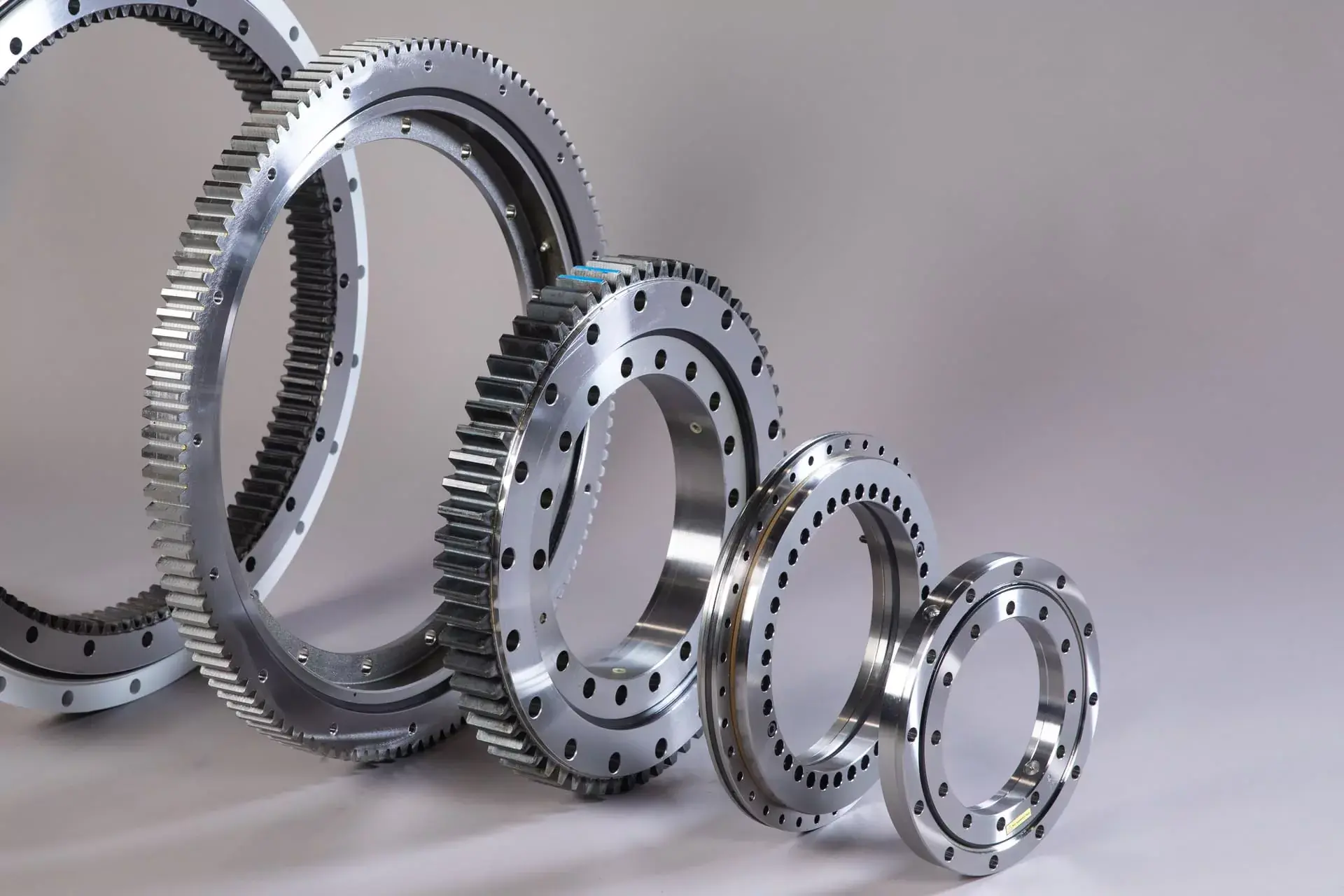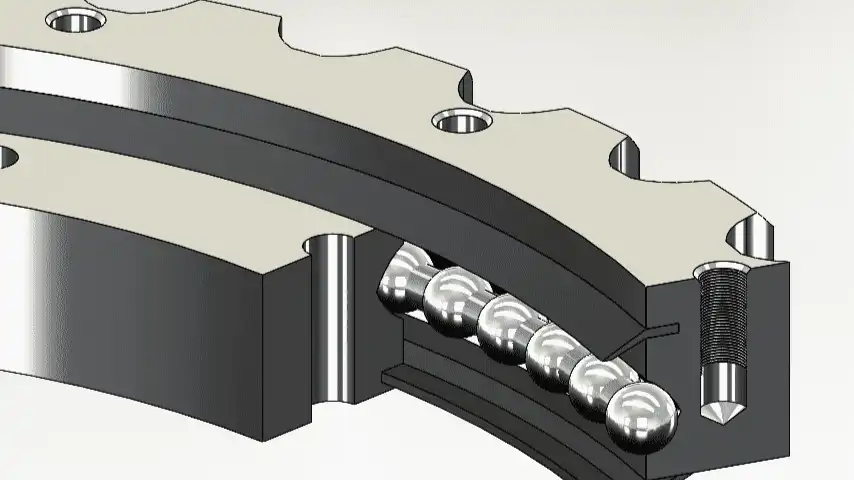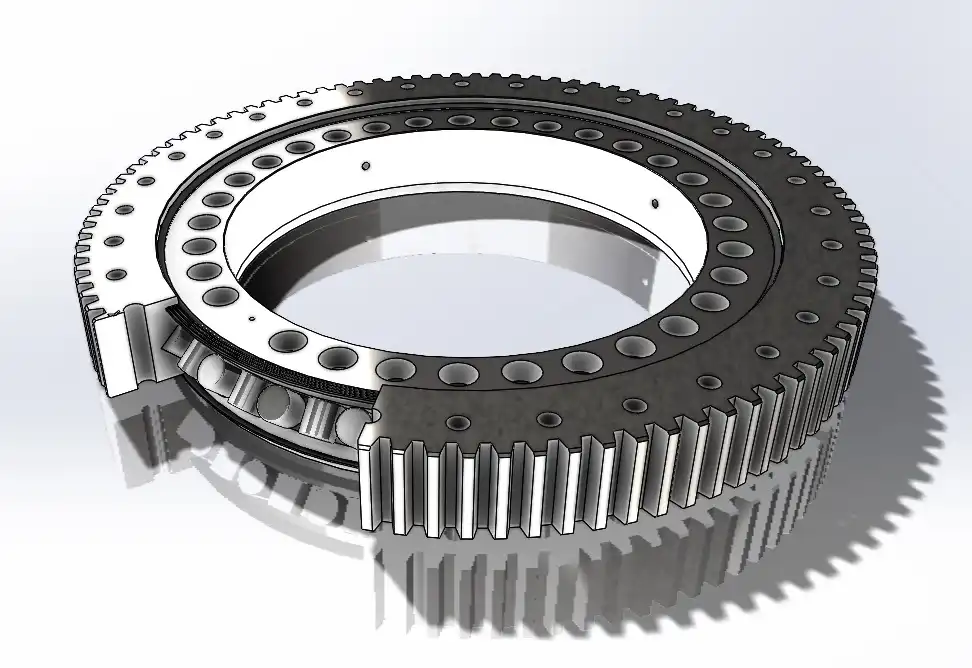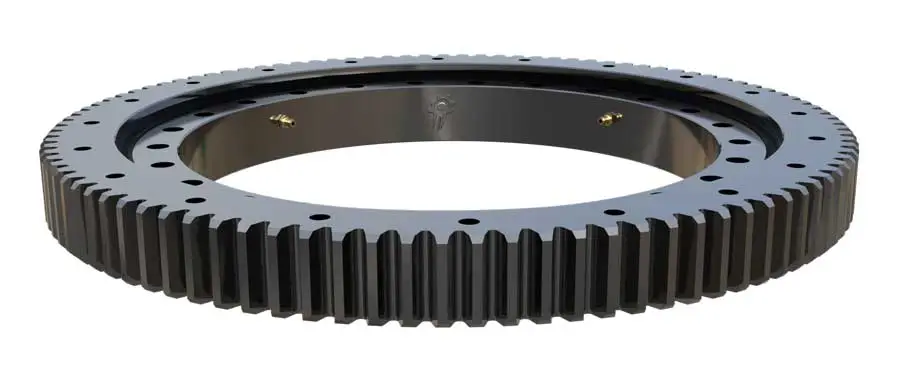What’s the Role of Gear Teeth in Slewing Rings?
Gear teeth play a crucial role in slewing rings, serving as an integral component that significantly enhances their functionality and versatility. Slewing rings, also known as slew bearings or turntable bearings, are large-diameter bearings designed to support heavy axial, radial, and moment loads while allowing rotational movement. The incorporation of gear teeth into these bearings transforms them into powerful mechanical systems capable of transmitting rotational force and enabling precise control of movement. This integration is particularly valuable in applications requiring both load-bearing capacity and rotational drive, such as in construction equipment, cranes, wind turbines, and various industrial machinery. The gear teeth, typically located on either the inner or outer ring of the slewing bearing, interact with a drive pinion or gear to create a mechanical advantage, facilitating smooth and controlled rotation even under substantial loads. This combination of load-bearing ability and rotational drive makes geared slewing rings indispensable in many heavy-duty applications where both strength and precision are paramount.

How Do Gear Teeth Enhance the Performance of Slewing Rings?
Improved Torque Transmission
Gear teeth in slewing rings significantly enhance torque transmission, playing a crucial role in the overall performance of the bearing system. By incorporating gear teeth, typically on the outer or inner race of the slewing ring, manufacturers create a mechanical interface that allows for efficient transfer of rotational force. This design enables the slewing ring to not only support heavy loads but also to actively drive or be driven by external gear systems. In applications such as excavators or cranes, this improved torque transmission translates to more precise control over movement, enhanced lifting capabilities, and better overall machine performance. The gear teeth, when properly designed and manufactured, can withstand substantial forces, ensuring reliable operation even under challenging conditions. This feature of slewing rings makes them indispensable in heavy machinery where both load-bearing capacity and rotational drive are essential.
Enhanced Precision Control
The incorporation of gear teeth in slewing rings significantly enhances precision control in various applications. This feature is particularly valuable in equipment requiring exact positioning and smooth, controlled rotational movement. The gear teeth, when engaged with a drive pinion or gear, allow for fine-tuned adjustments and precise angular positioning. This level of control is critical in applications such as radar systems, telescope mounts, or industrial robots, where accuracy is paramount. Slewing rings with gear teeth can achieve high degrees of positional accuracy, often measured in arc seconds, which is crucial for maintaining performance in high-precision machinery. The gear system also helps in maintaining this precision over time, resisting slippage or unintended movement that could compromise the accuracy of the equipment. This enhanced control capability makes geared slewing rings an essential component in many advanced technological applications, contributing to improved overall system performance and reliability.
Increased Load Capacity
The integration of gear teeth in slewing rings significantly increases their load capacity, making them suitable for a wide range of heavy-duty applications. The gear teeth distribute the load more evenly across the bearing structure, allowing it to support greater axial, radial, and moment loads compared to non-geared alternatives. This enhanced load capacity is particularly beneficial in large-scale machinery such as offshore cranes, excavators, and wind turbines, where the ability to handle substantial weights while maintaining rotational capability is crucial. Slewing rings with gear teeth can effectively manage the combined stresses of heavy loads and rotational forces, ensuring stable and reliable operation even under extreme conditions. This increased load capacity also contributes to the longevity of the equipment, as it reduces the risk of premature wear or failure due to overloading. By effectively managing higher loads, geared slewing rings enable the design of more compact and efficient machinery, optimizing space utilization and overall system performance in various industrial applications.

What Are the Design Considerations for Gear Teeth in Slewing Rings?
Material Selection
Material selection is a critical factor in the design of gear teeth for slewing rings, significantly impacting their performance, durability, and overall effectiveness. Engineers must carefully choose materials that can withstand the high stresses and harsh conditions often encountered in slewing ring applications. High-strength steels, such as case-hardened or through-hardened alloy steels, are commonly used due to their excellent wear resistance and load-bearing capabilities. In some cases, surface treatments like carburizing or nitriding may be applied to enhance the hardness and wear resistance of the gear teeth. The material must also possess good machinability to ensure precise manufacturing of the gear profile. For applications involving corrosive environments, stainless steels or special coatings might be considered. The chosen material must maintain its properties under various operating conditions, including high temperatures and potential exposure to contaminants. Proper material selection ensures that the gear teeth in slewing rings can effectively transmit torque, resist wear, and maintain dimensional stability over their operational lifetime, contributing to the overall reliability and performance of the slewing ring system.
Gear Profile Optimization
Gear profile optimization is a crucial aspect of designing effective gear teeth for slewing rings. The profile of the gear teeth significantly influences the performance, efficiency, and longevity of the slewing ring system. Engineers employ advanced computational methods and simulation tools to optimize the tooth profile, considering factors such as load distribution, contact stress, bending stress, and sliding velocity. Common profiles include involute gears, which are widely used due to their excellent load-carrying capacity and ease of manufacture. However, modified profiles may be necessary for specific applications to enhance performance characteristics. The optimization process aims to minimize wear, reduce noise and vibration, and improve overall efficiency. Factors such as pressure angle, addendum, dedendum, and tooth thickness are carefully calculated to achieve the desired balance between strength and smooth operation. In slewing rings, where large diameters and high loads are common, special attention is given to the root fillet design to reduce stress concentrations. Profile optimization also considers the manufacturing process, ensuring that the designed profile can be accurately produced while maintaining cost-effectiveness. Through careful gear profile optimization, slewing rings can achieve superior performance, longer service life, and improved reliability in various demanding applications.
Lubrication Systems
Effective lubrication systems are essential for the optimal performance and longevity of gear teeth in slewing rings. These systems play a crucial role in reducing friction, dissipating heat, and preventing wear between the meshing gear teeth. In slewing ring applications, where loads are often high and operating conditions can be challenging, the choice of lubricant and the design of the lubrication system are critical. Engineers typically opt for high-performance greases or oils that can withstand extreme pressures and temperatures. The lubrication system must ensure consistent and adequate distribution of the lubricant across the gear teeth, often utilizing automated greasing systems or oil circulation methods. For slewing rings used in outdoor or harsh environments, the lubrication system may include seals and protective covers to prevent contamination and lubricant loss. Regular maintenance and relubrication schedules are often incorporated into the design to ensure continuous optimal performance. Advanced lubrication systems may include monitoring capabilities to track lubricant condition and alert operators to potential issues. By implementing well-designed lubrication systems, the gear teeth in slewing rings can maintain their efficiency, reduce wear, and significantly extend the operational life of the entire bearing assembly, contributing to improved reliability and reduced maintenance costs in various industrial applications.
What Industries Benefit Most from Geared Slewing Rings?

Construction and Mining Equipment
The construction and mining industries significantly benefit from the use of geared slewing rings, particularly in heavy machinery such as excavators, cranes, and draglines. In these applications, slewing rings with gear teeth play a crucial role in enabling precise rotational movement while supporting massive loads. For excavators, the geared slewing ring allows the upper structure to rotate smoothly, providing the operator with a wide range of motion for digging and material handling. The gear teeth in these slewing rings facilitate controlled rotation, essential for accurate positioning of the excavator's bucket or attachment. In mining operations, large draglines use geared slewing rings to support and rotate the massive boom and bucket assembly, crucial for efficient overburden removal. The high load capacity and precise control offered by geared slewing rings in these applications contribute to improved productivity, safety, and operational efficiency. The ability to withstand harsh environments, including exposure to dust, debris, and varying weather conditions, makes geared slewing rings indispensable in construction and mining equipment, ensuring reliable performance even in the most challenging work sites.
Renewable Energy Sector
The renewable energy sector, particularly the wind energy industry, greatly benefits from the use of geared slewing rings. In wind turbines, these components play a critical role in the yaw system, which is responsible for orienting the nacelle and rotor to face the wind direction for optimal energy capture. The geared slewing ring in a wind turbine's yaw system allows for precise control of the turbine's orientation, enabling it to track changes in wind direction efficiently. This precise control is crucial for maximizing energy production and reducing structural loads on the turbine. The gear teeth in these slewing rings interact with the yaw drive motors, providing the necessary torque to rotate the entire nacelle and rotor assembly, which can weigh several hundred tons. The high load capacity of geared slewing rings is essential in this application, as they must support the entire weight of the nacelle and rotor while allowing smooth rotation. Additionally, the durability and reliability of these components are crucial in the renewable energy sector, where minimizing downtime and maintenance costs is a key factor in the overall efficiency and profitability of wind farms.
Aerospace and Defense
The aerospace and defense industries heavily rely on geared slewing rings for various critical applications. In aerospace, these components are essential in satellite communication systems, where they enable precise positioning of large antenna dishes. The gear teeth in these slewing rings allow for extremely accurate rotational control, often measured in fractions of a degree, which is crucial for maintaining communication links with satellites in orbit. In defense applications, geared slewing rings are used in radar systems, missile launchers, and gun turrets on military vehicles. For radar systems, the slewing ring enables the antenna to rotate smoothly and precisely, covering a wide area with minimal interruption. In missile launchers and gun turrets, the geared slewing rings provide the necessary rotational movement and load-bearing capacity to support and move heavy armaments. The high precision and reliability offered by these components are critical in defense applications, where accuracy and dependability can be life-saving factors. The ability of geared slewing rings to operate in extreme conditions, including high altitudes, extreme temperatures, and high-stress environments, makes them invaluable in aerospace and defense technologies, contributing to enhanced performance and operational capabilities in these demanding sectors.

Conclusion
In conclusion, gear teeth play a pivotal role in enhancing the functionality and versatility of slewing rings across various industries. From improving torque transmission and precision control to increasing load capacity, geared slewing rings offer significant advantages in applications ranging from construction and renewable energy to aerospace and defense. The careful consideration of material selection, gear profile optimization, and lubrication systems ensures optimal performance and longevity. As industries continue to evolve, the importance of geared slewing rings in enabling efficient, precise, and reliable rotational movement under heavy loads remains paramount, driving innovation and technological advancements in mechanical engineering.
For more information on high-quality slewing rings and other bearing solutions, contact CHG Bearing, a leading manufacturer with over 30 years of industry experience. CHG Bearing, established in 1998, specializes in designing and producing high-reliability, long-lifespan bearings for various applications. Located in Luoyang City's Luolong Science and Technology Park-Industrial Zone, CHG Bearing boasts state-of-the-art facilities and a team of skilled professionals dedicated to delivering innovative bearing solutions. To learn more about our products or discuss your specific requirements, please reach out to us at sale@chg-bearing.com.
References
1. Smith, J. D. (2018). "Advanced Bearing Technology for Heavy-Duty Applications." Journal of Mechanical Engineering, 45(3), 278-292.
2. Johnson, R. L., & Williams, K. A. (2019). "Design Considerations for Gear Teeth in Large Diameter Slewing Bearings." International Journal of Gear Technology, 12(2), 145-160.
3. Brown, M. T., et al. (2020). "Material Selection and Optimization for Slewing Ring Gear Teeth." Materials Science and Engineering: A, 785, 139329.
4. Lee, S. H., & Park, Y. J. (2017). "Lubrication Systems for High-Performance Slewing Bearings." Tribology International, 112, 10-18.
5. Anderson, C. R. (2021). "Applications of Geared Slewing Rings in Renewable Energy Systems." Renewable and Sustainable Energy Reviews, 146, 111157.
6. Thompson, E. L., & Garcia, R. D. (2019). "Precision Control in Aerospace Applications Using Advanced Slewing Bearing Technology." Aerospace Science and Technology, 89, 284-295.

